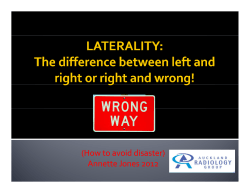
Document 410022
Common Compensatory Pattern – Treatment in a Busy Practice David R. Boesler, D.O. Chair, Department of Neuromusculoskeletal Medicine Nova Southeastern University What is the Common Compensatory Pattern? An alternating pattern of fascial preferences Fascia is affected by a person’s structural, functional, and emotional stresses Fascia responds to stresses, and absorbs and distributes forces placed upon it Fascial strains disrupt the normal homeostatic mechanisms in the body Alternating fascial patterns in the body can be a homeostatic response to stressors when an “ideal” cannot be met Common Can be found in large portion of the population Seen in both symptomatic and asymptomatic people Compensatory “ The fascia is the place to look for the cause of disease and the place to consult and begin the action of remedies in all diseases” Common Compensatory Pattern (CCP) An efficient way to structurally evaluate and treat your patient A blueprint to follow in the treatment of the axial skeleton A pattern of treatment utilizing the four major diaphragms of the body Four Major Transverse Diaphragms of the Body Pelvic diaphragm Thoracoabdominal (respiratory) diaphragm Cervicothoracic (thoracic inlet) diaphragm Tentorium cerebelli Respiratory-Circulatory Model Addresses both the respiratory and circulatory system in the homeostatic response Encourages proper oxygenation to the cells, tissues, and organs; and proper removal of waste products from the tissues, cells, organs Respiratory-Circulatory Model Concerned with delivering oxygen and nutients to the tissues and removal of cellular waste products This treatment plan will encourage proper healing from any source, whether structural or visceral dysfunction D.O. = Deliver Oxygen From Kuchera and Kuchera 1994 OA Compensated Patterns: •L/R/L/R •R/L/R/L CT TL LS OA Uncompensated Patterns CT TL LS The transitional areas of the spine are commonly the areas that can be subject to the greatest trauma. where the head meets the neck where the neck meets the thorax where the thorax meets the lumbar spine where the lumbar spine meets the pelvis Restriction in any of these transitional areas can cause major alterations in the function of the surrounding structures, and can directly or indirectly affect the health of the body History of CCP J. Gordon Zink, D.O., F.A.A.O. Late 1970’s Correlated data from patients Published first article on CCP in 1979 Zink found these alternating patterns in patients who were “healthy” individuals. Patients who did not have an ideal fascial pattern, or no fascial preferences were considered non-compensated. These non-compensated patterns were usually traumatic in origin, or seen in chronic illnesses. Zink found that if a patient’s fascia fell into a certain pattern of compensation, they tolerated stress and disease better than those who did not. These patients also better tolerated any somatic dysfunctions they had. These patients also were found to recover quicker and respond to medical care more predictably. The Common Pattern Lumbosacral area – rotated right Thoracolumbar area – rotated left Cervicothoracic area – rotated right Upper cervical area – rotated left From Kuchera and Kuchera 1994 CCP 1. Innominate rotation 2. Sacrum 3. Lumbosacral area 4. Thoracolumbar junction 5. Lower left ribs 6. Upper left ribs 7. Upper right thoracic vertebrae 8. Cervicothoracic junction 9. Upper cervical area (including OA) The transitional areas of the spine are commonly the areas that can be subject to the greatest trauma. where the head meets the neck where the neck meets the thorax where the thorax meets the lumbar spine where the lumbar spine meets the pelvis From Kuchera and Kuchera 1994 What will addressing this CCP do? Relieve myofascial torsions in the body Affect the autonomic nervous system Improve diaphragmatic function Improve venous/lymphatic flow It’s time to get your Osteopathic Hands on! CCP 1. Innominate rotation 2. Sacrum 3. Lumbosacral area 4. Thoracolumbar junction 5. Lower left ribs 6. Upper left ribs 7. Upper right thoracic vertebrae 8. Cervicothoracic junction 9. Upper cervical area (including OA)
© Copyright 2025




















